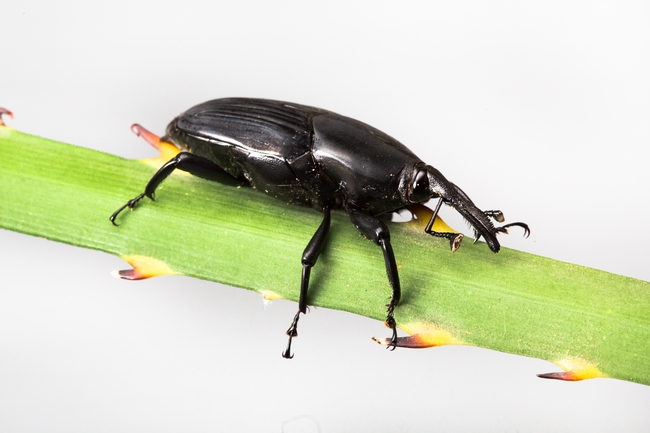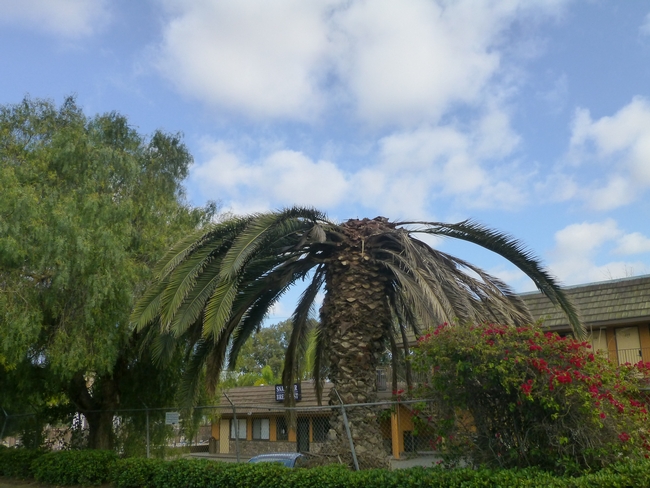Is 'palmageddon' coming to California?
Representatives from the date and ornamental palm industries, arborists and pest managers, parks and recreation officials, and home owners are uniting behind a University of California, Riverside initiative to slow the spread of the South American palm weevil, a palm tree-killing insect that has established in San Diego County.
“Everyone recognizes the threat and agrees it is significant,” said Mark Hoddle, UC Cooperative Extension specialist in biological control based at UC Riverside.
However, Hoddle said, action is hampered significantly by a lack of financial support at the state and federal level for research to answer questions about the distribution of the weevil in Southern California, how far it can fly from infestation zones, control options, and the most efficient and sensitive ways to monitor and trap it.
Hoddle recently helped organize a symposium just outside San Diego on the South American palm weevil. Recent detection in California of the weevil, which has traditionally been found in South and Central America, the Caribbean and Mexico, has scientists, farmers and nursery industry officials worried because it threatens California's $70 million ornamental palm industry and $68 million commercial date industry.
“My personal feeling is we might be on the verge of a crisis now,” Hoddle said. “The big problem is we don't know how far the weevil has spread. We really need help from the public in tracking its spread.”
The South American palm weevil (Rhynchophorus palmarum) is not to be confused with the palm weevil Rhynchophorus vulneratus, which originated from Indonesia and was incorrectly identified as the red palm weevil, Rhynchophorus ferrugineus, when it was found killing palm trees in Laguna Beach in 2010. R. vulneratus was declared eradicated from California on Jan. 20, 2015.
Feeding by larvae of the South American palm weevil damage the growing area of the crown of palm trees. The tree is then unable to produce new fronds, and within months it dies. Canary Islands date palms are particularly vulnerable and it is likely date palms will be attacked too. California also has a native palm species (Washingtonia filifera), which grows in desert oases and may be vulnerable to attack.
Detection of the South American palm weevil was officially confirmed May 9, 2011. Seven additional detections were made in July and August 2011. These initial detections by the USDA were in San Ysidro in San Diego County, about two miles from the Mexican border. It is likely that the weevils flew from Tijuana, Mexico, where infestations and dead palms had been detected in December 2010.
As a result of those detections, weevil traps were set up throughout California, Arizona and Texas with financial support from the USDA. A total of 111 South American palm weevils were captured in California; 109 in San Diego County and two in Imperial County. They were also found in Alamo, Texas, and Yuma, Ariz.
The traps were monitored from 2011 to 2013. Then, monitoring stopped when federal funding for the program expired.
Since monitoring stopped, it appears the problem has worsened, said Hoddle, who is also director of UC Riverside's Center for Invasive Species Research. In May 2016 he did a casual eight-hour driving survey in Tijuana, Mexico and found about 125 dead Canary Islands date palms that had been killed by the South American palm weevil.
In August, 2016, Hoddle placed 10 weevil traps at Sweetwater Regional County Park, about 15 miles east of San Diego. Since then, he has been catching about five to seven weevils per trap per month. In the coming months, he plans to start monitoring the heath of the palm trees in Sweetwater Regional Park using a drone.
Hoddle considers the South American palm weevil situation more dire than what he encountered with Rhynchophorus vulneratus because he fears the South American palm weevil has spread further and it spreads the red ring nematode (Bursaphelenchus cocophilus), which also kills palm trees.
Red ring nematodes, which have not yet been detected in California, can enter palm trees through the damage South American palm weevils do to the trees. The nematodes can also enter the bodies of the weevils when they are larvae. Then, the larvae turn into adult weevils which are strong flyers and they can then spread the nematode to other palms when the feed or lay eggs on them.




